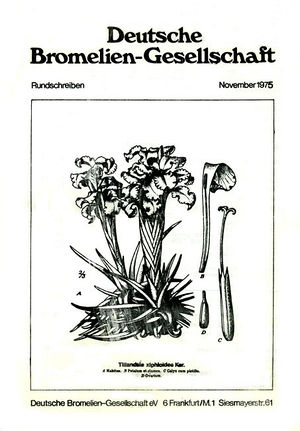From Deutsche Bromelien-Gesellschaft e. V.
(Difference between pages)
Jump to navigation
Jump to search
|
|
| Line 1: |
Line 1: |
| Nobody should presume he does not know any „Bromeliads“. For at least one species – in fact being not an ornamental but an economic plant - is on the tip of everybody’s tongue: the pineapple. She was the first representative of her family to find her way to Europe, rather soon after the discovery of America. The Bromeliads (lat.: Bromeliaceae) obtained their name by the French botanist Charles Plumier who published them 1703 for the first time, naming them after his friend, the Swedish physician and botanist Olaf Bromel (1639-1705). In german language generally the name “pineapple plants” is in use.
| | {{Rundschreiben| |
| | | year of publication = 1975 |
| | |}} |
| | {{German only}} |
| | == Table of contents == |
| | * Author (full name) - Title of article, latin plantnames ''italic''. |
| | * Author (full name) - Title of article, latin plantnames ''italic''. |
| | * Author (full name) - Title of article, latin plantnames ''italic''. |
|
| |
|
| | | {{magazine-download}} |
| == Habitats ==
| |
| | |
| Bromeliads are growing exclusively in the New World, which means North and South America. Solely the species Pitcairnia Feliciana also exists in the western Africa. The distribution area of Bromeliads ranges from the South of the USA over Central America far down to Argentina and Chile. They thrive in nearly every living environment, including all deserts of the Western Hemisphere, even inclusive of the desert most arid in the world, the Atacama. Wether moist and hot lowland rainforests, dry cactus and thorn forests, or moist and could rain- and cloud forest of the mountains, even on the table mounts of Venezuela (Tepuis) and in the Páramos of the Andes, more than 4000m high, are to be found Bromeliads.
| |
| | |
| | |
| == Ecology ==
| |
| | |
| About half of the known Bromeliad species live epiphytic, meaning they grow on other plants, but without feeding on them. '''They are no parasites''', what they are often erroneously called and – alas - are treated likewise by locals. However Bromeliads can also be found living on rocks (litophytic) or on the ground (terrestrial). As their habitats dry out severely sometimes, some of them started building a funnel or a cistern with the use of the base of their leafs, to catch and keep water. The biggest species can this way store up several liters of water, which assists them to compensate rather long dry periods. At the same time these minuscule lakes represent a self-contained biotope and provide living space for several other creatures, often to the benefit of both. The funnels serve insect species as breeding place for their nymphs, tropical tree frogs live and spawn in them, and even several water plants grow there. Even crabs have been found in Bromeliad cisterns. In nutrient-poor regions a few Bromeliads actually have developed the ability to live as carnivores.
| |
Revision as of 15:00, 3 July 2013
Please note that the older publications of the DBG were released in german language only. They mostly did not contain any english abstracts or translations of the articles. If so, it will be added below.
Table of contents
- Author (full name) - Title of article, latin plantnames italic.
- Author (full name) - Title of article, latin plantnames italic.
- Author (full name) - Title of article, latin plantnames italic.

|
This issue can be downloaded here as PDF file.
To view it you need a PDF-Reader such as Acrobat Reader.
File size: {{{file-size}}}
|
